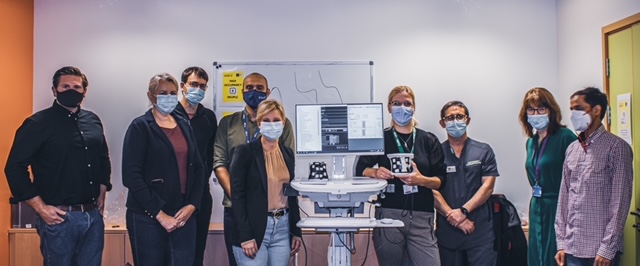NIOMI
Non-Invasive lung Oxygen Monitoring of term Infants

Background
Infants born prematurely are very likely to require respiratory support in the neonatal unit due to respiratory distress syndrome (RDS) which is caused by the lack of surfactant in the lungs. Pathomorphological feature of RDS include the collapse of alveolar sacks resulting in decrease of blood-oxygen saturation. Fast detection and diagnosis are critical in order to administer treatment and prevent potential long-term health complications. RDS is currently monitored via sampling of arterial blood, pulse oximetry and x-ray imaging. These methods cannot measure lung oxygen concentration or volume directly and carry some short and long-term risks.
The direct lung oxygen concentration and lung volume measurement presents a potential clinical and diagnostic advantage because, optical measurements can be used to locate the areas of the lung with low oxygen concentration and/or reduced gas volume repeatedly or continuously, without potential health risks.
The lung oxygen concentration measurement is based on Gas in Scattering Media Absorbance Spectroscopy (GASMAS) method. This technique takes advantage of the very sharp, optical spectral features of gases such as oxygen and water vapor. Relative to lung and overlying tissues, oxygen and water vapor gases absorb very specific wavelengths of light, 764nm for oxygen and 820nm or 935nm for water vapor, respectively. By looking for the sharp absorption imprints in spectra of light emerging from the infant lungs, it is possible to detect gases confined within and reveal the location and the extent of collapsed lung tissue.
First, using the 935nm laser, the water vapor concentration is measured. Assuming that relative humidity is 100% in the lungs and tissue temperature is 37℃, the instrument calculates the absorption path length which is an indirect parameter corelating with lung gas volume. Then, using the 764nm laser, the instrument measures the oxygen gas absorption. By assuming the same absorption path length for both gases, the instrument can calculate the oxygen concentration in the probed volume of lung tissue.
NEOLA Lung analyzer (GPX medical, Sweden) is used to perform measurements as a part of the study called NIOMI (Non-Invasive Oxygen Measurement in Infants). To obtain the lung oxygen measurements, the system uses diffuse light from two low power, near-infrared lasers coupled into small probe and photosensor detecting the light coming back from the tissues.
Trial Objectives and Purpose
The purpose of this observational study is to answer several technical questions.
- Can the GASMAS system detect oxygen in the lungs of healthy, full term infants?
- Can this system measure the oxygen concentration?
- What is the oxygen concentration variation for consecutive measurements?
- Is there an optimal position of the light source and photodetector on the torso of the infant that produces consistent measurements with acceptable signal to noise ratio?
Results obtained from the NIOMI study will generate information to guide the development of the GASMAS-based systems for future clinical adaptation in preterm infants.
Principal Investigator: Prof Eugene Dempsey
Local Principal Investigators: Dr. Jurate Panaviene, Dr. David Healy, Dr. Roberto Chioma, Dr. Nahla Ahmed
Collaborators (Tyndall@biophotonics): Prof. Stefan Andersson-Engels, Ms Andrea Pacheco, Mr Konstantin Grygoryev, Mr Sanatana Mr Pranav Lanka, Mr Sanathana KONUGOLU




